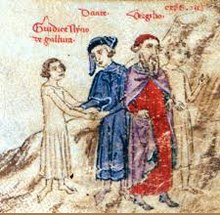Allen Mandelbaum was an American professor of literature and the humanities, poet, and translator from Classical Greek, Latin and Italian. His translations of classic works gained him numerous awards in Italy and the United States.

Ugolino della Gherardesca, Count of Donoratico, was an Italian nobleman, politician and naval commander. He was frequently accused of treason and features prominently in Dante's Divine Comedy.

Comita III was the giudice of Logudoro, with its capital at Torres, from 1198 until 1218. He was the youngest of four sons of Barisone II of Torres and Preziosa de Orrubu. He ruled at a time when the great families, usually foreign, were superseding the giudici in power and influence on Sardinia.

Obizzo II d'Este was Marquis of Ferrara and Ancona.

The Judicate of Gallura was one of four Sardinian judicates in the Middle Ages. These were independent states whose rulers bore the title iudex, judge. Gallura, a name which comes from gallus, meaning rooster (cock), was subdivided into ten curatoriae governed by curatores under the judge. In the 13th century, the arms of Gallura contained a rooster.
Torchitorio V, born John and known as Chiano or Chianni, was the Giudice (Judge) of Cagliari from 1250 to his death. His reign was brief but transformative in the history of Sardinia.
JohnVisconti was the Judge of Gallura from 1238 to his death. He was a member of the Visconti dynasty of Pisa.
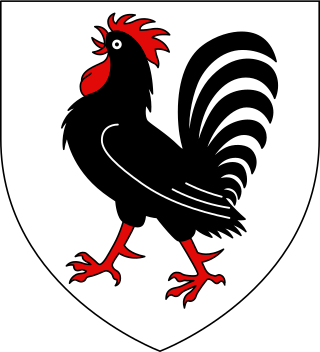
Joannaof Gallura, also known as Giovanna Visconti, was the last titular Judge (giudicessa) of Gallura. Joanna claimed her rights in Sardinia to no avail and eventually sold them to her relatives, the Visconti of Milan, who later sold them to the Crown of Aragon. She is mentioned passingly by Dante Alighieri in the Divine Comedy. Her father, a friend of Dante's, but consigned to Purgatory with the other negligent rulers, asks her to be reminded of him.

The House of Gherardesca was an ancient Italian noble family of the Republic of Pisa, of Longobard origin. The family likely dates back as early as the 11th century.
William of Capraia was the regent for Marianus II of Arborea from 1241 until his death, being entitled "Judge" from 1250 on.
Anselm of Capraia was a Pisan count. His political activity extended from the Republic of Pisa to Sardinia.
Luchetto Gattilusio was a Genoese statesman, diplomat, and man of letters. As a Guelph he played an important role in wider Lombard politics and as a troubadour in the Occitan language he composed three poems descriptive of his times.
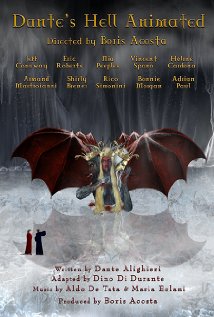
Dante's Hell Animated is a 2013 American animated short film produced and directed by Boris Acosta.
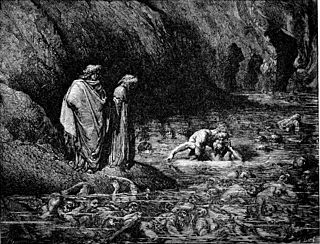
Ruggieri degli Ubaldini was an Italian archbishop.

The Visconti of Pisa and Sardinia were an Italian noble dynasty of the Middle Ages. They achieved prominence first in Pisa, then in Sardinia, where they became rulers of Gallura.
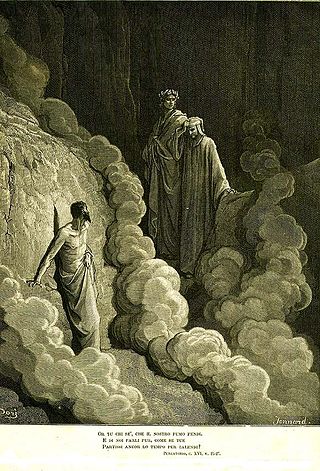
Marco Lombardo was a courtier from medieval Lombardy. His date of birth and true identity are unknown, but he is thought to have lived during the second half of the thirteenth century. He is also believed to have served many courts and possibly those of Gherardo III da Camino and Ugolino della Gherardesca. He was widely known in medieval Italy and appeared as a character of anecdotes and short stories even before Dante's creation of the Divine Comedy.

Matelda, anglicized as Matilda in some translations, is a minor character in Dante Alighieri's Purgatorio, the second canticle of the Divine Comedy. She is present in the final six cantos of the canticle, but is unnamed until Canto XXXIII. While Dante makes Matelda's function as a baptizer in the Earthly Paradise clear, commentators have disagreed about what historical figure she is intended to represent, if any.
Alagia Fieschi, also known as Alagia di Nicolò Fieschi and Alagia di Fieschi, was the daughter of Count Nicolò Fieschi and niece of Pope Adrian V. Alagia married Moroello Malaspina in the 1280s and they had five children. In Dante Alighieri's Divine Comedy, Alagia is remembered by Adrian V at the end of his conversation with Dante as the only virtuous woman in his family whom he wishes to pray on his behalf. Alagia’s mention as the only virtuous person in her family reflects Dante’s view about Alagia's family's actions involving the Malaspina family. In addition, Alagia is celebrated by Dante through his portrayal of her as a virtuous woman whose prayer can contribute to Adrian V's journey of salvation.

Beatrice d’Este was an Italian noblewoman, now primarily known for Dante Alighieri's allusion to her in Purgatorio, the second canticle of the Divine Comedy. Through her first marriage to Nino Visconti, she was judge (giudichessa) of Gallura, and through her second marriage to Galeazzo I Visconti, following Nino’s death, lady of Milan.
Michele Zanche was an Italian politician, best known as a character in Dante Alighieri's Divine Comedy, where he is mentioned in Canto XXII of Inferno, in the fifth bolgia of the eighth circle, among the barrators, together with Friar Gomita, vicar of Nino Visconti judge of Gallura. He married Simona Doria, from the famous and wealthy Genoese family.
